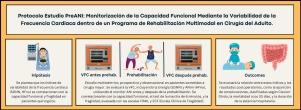多模式成人手术康复方案中功能能力评估的心率变异性:ANI前研究方案
IF 0.8
Q3 ANESTHESIOLOGY
Revista Espanola de Anestesiologia y Reanimacion
Pub Date : 2025-05-12
DOI:10.1016/j.redar.2025.501849
引用次数: 0
摘要
背景与目的尽管实施了多模式康复方案,但术后并发症在一些手术中很常见,患者的恢复并不像预期的那样快。本研究旨在通过评估术前功能储备和虚弱程度(基于心率变异性,特别是能量和ANIm值)来评估患者在康复前的预后是否可以得到改善。材料和方法前瞻性、观察性队列研究,将包括在多模式康复计划中接受结直肠肿瘤手术的患者。患者将在2个时间点使用ANI设备进行监测:初始(第一次麻醉前会诊,术前4周)和第二次会诊(术前1周)。将收集心率变异性、能量和animm值、心肺运动测试分数和其他参数的数据。结果我们将分析心率变异性指标与当前功能评估参数、生理储备和虚弱(ASA量表、6分钟步行测试、MUST量表和临床虚弱量表)之间的相关性。我们的假设是,更高的能量水平与更好的术后结果、更少的并发症和更短的住院时间相关。统计分析将尊重所有保密和隐私原则。研究结果将发表在同行评议的期刊上。结论本研究旨在为评估手术患者的虚弱和功能储备提供一种新的工具,作为改善康复计划和术后预后的手段。本文章由计算机程序翻译,如有差异,请以英文原文为准。

Variabilidad de la frecuencia cardiaca para la evaluación de la capacidad funcional en programas de rehabilitación multimodal en cirugía del adulto: Protocolo Estudio PreANI
Background and objectives
Despite the implementation of multimodal rehabilitation programs, postoperative complications are common in some surgeries, and patient recovery is not as rapid as expected. This study was designed to evaluate whether postoperative outcomes can be improved by assessing preoperative functional reserve and frailty on the basis of heart rate variability, specifically energy and the ANIm value, in patients following prehabilitation programs.
Material and method
Prospective, observational cohort study that will include patients undergoing colorectal oncology surgery within a multimodal rehabilitation program. Patients will be monitored with the ANI device at 2 time points: initial (first pre-anaesthesia consultation, 4 weeks before surgery) and second consultation (1 week before surgery). Data will be collected on heart rate variability, energy, and ANIm values, cardiopulmonary exercise test scores, and other parameters.
Results
We will analyse the correlation between heart rate variability indices and current functional assessment parameters, physiological reserve, and frailty (ASA scale, 6-minute walk test, MUST scale, and Clinical Frailty Scale). Our hypothesis is that higher energy levels will correlate with better postoperative outcomes, fewer complications, and shorter hospital stays. Statistical analysis will respect all principles of confidentiality and privacy. The results will be published in peer-reviewed journals.
Conclusions
This study aims to provide a new tool for assessing frailty and functional reserve in surgical patients as a means of improving prehabilitation programs and postoperative outcomes.
求助全文
通过发布文献求助,成功后即可免费获取论文全文。
去求助
来源期刊

Revista Espanola de Anestesiologia y Reanimacion
ANESTHESIOLOGY-
CiteScore
1.80
自引率
15.40%
发文量
113
审稿时长
82 days
 求助内容:
求助内容: 应助结果提醒方式:
应助结果提醒方式:


